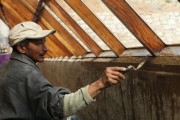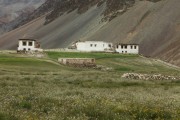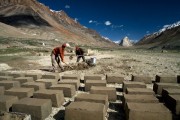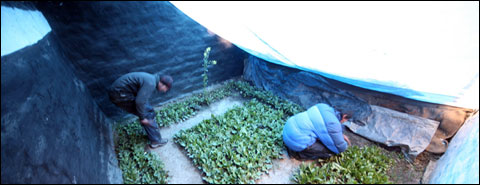A School for Kargyak: We're Building a Greenhouse
A pilot construction of a greenhouse started in a Himalayan village Kargyak (4200 metres elevation above sea-level). It has to test a construction, which will be used later by the Czech volunteers, while building a school. The Sun School, heated by a solar energy, will give local children a chance to learn how to read and write.
Author of the school project, Honza Tilinger from ČVUT (Czech Technical University), describes the process of the works.
We launched the building of a greenhouse, which is partly an experimental construction, partly examination of the villagers, how much are they ready to put the hand on work for free, while raising their own well-being. Surprisingly a lot.
First of all, of course, were long discussions, followed by drinking their brandy "cchang", then another discussion. Today, every morning six of them step into work on their greenhouse, though each of them has a plenty of seasonal labor on his own farm. Who will take part on works on the greenhouse is determined by lot. They throw dice, mumbled from campa (whole-meal flour with water). The one with the lowest number is chosen. He stands to work with a smile and without grunting. Lama, who arrived to his home village from a Karnataka monastery, toils the most, although he doesn't have to at all. Just as the oldest man of the village, an 84-year old-fellow, works like a beaver.
The third day of digging, a group of six women managed to trench down to an enormous stone, that was - according to me - to be blasted by a dynamite, or for a herd of yaks. But all of the men gathered around, they dug under it in various ways for a while, and then part of them shore up, sitting just one by another. The rest of them, standing, put their legs through the sitting men and, strutted by a slope, little by little, were gradually lifting the stone up, meanwhile the women were inserting stony trigs under it. Thus like on the Easter Islands, they shifted it step by step for four meters!
Apart from that, with the locals it is sometimes hard. Perhaps two years ago already, the village gained a water-hose from the government for water distribution between the houses, but nobody knew what to do with it. So they had took it into parts and when we arrived, there were bits of the hose among the straw, yakzee (willow twigs) and yak dung on every roof. We ourselves had to gather the lumps up, reassemble and lead on to a brook. The hose warms up in the sun during the noon and around 2 p.m., when the sunrays quite burn, it is fairly well possible to shower.
Unfortunately, impregnating the aspen wood with the yak's blood didn't take place, as it would cost in conversion round 6000 Czech Crowns. We put up back with the blood from the sheep, which was ten times cheaper. We tried out his autumn blood, that is so heavy, that within 20 seconds on the air changes into aspic. In spite of that we successfully coated the beam with three layers of blood and it looks great so far. Goulash from mutton was excellent - especially after days spent with the villagers, when the only things we eat is campa and salty tea.

 In now days are hppening big changes in Jammu and Kashmir.
https://www.bbc.com/news/world/asia/india
In now days are hppening big changes in Jammu and Kashmir.
https://www.bbc.com/news/world/asia/india  On September 21st, Kargyak Sun School will celebrate the 10th anniversary of its opening. There, in one of the last places on Earth, the original Tibetan culture survives at the elevation of 4200 m. Before the school opened, the village of 200 heads had only 10 members who could read and write a little. To get an education, children were sent away to boarding schools in faraway towns. Today, the Sun School has its alumni and thanks to the project, people stopped moving away from the village.
On September 21st, Kargyak Sun School will celebrate the 10th anniversary of its opening. There, in one of the last places on Earth, the original Tibetan culture survives at the elevation of 4200 m. Before the school opened, the village of 200 heads had only 10 members who could read and write a little. To get an education, children were sent away to boarding schools in faraway towns. Today, the Sun School has its alumni and thanks to the project, people stopped moving away from the village.  PRAHA 22.11.2018 | 19:00 Betlémská kaple
BRNO 21.11.2018 | 19:00 Milosrdní bratři
PRAHA 22.11.2018 | 19:00 Betlémská kaple
BRNO 21.11.2018 | 19:00 Milosrdní bratři 



